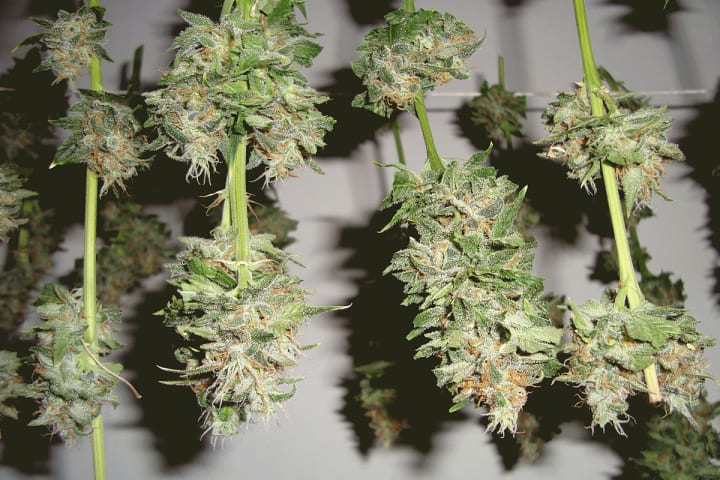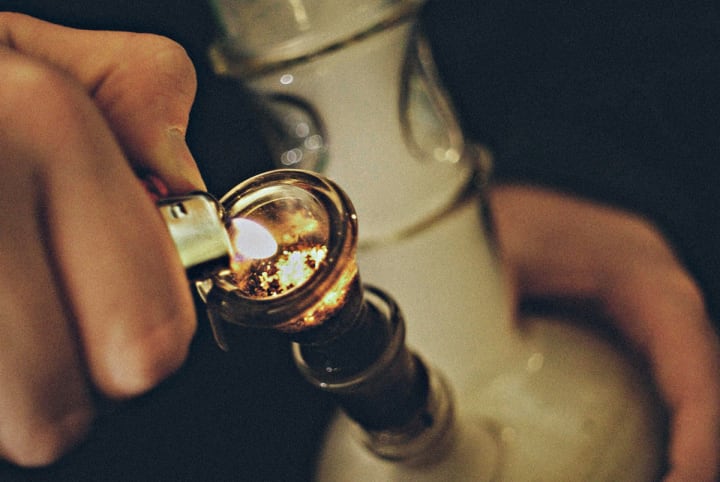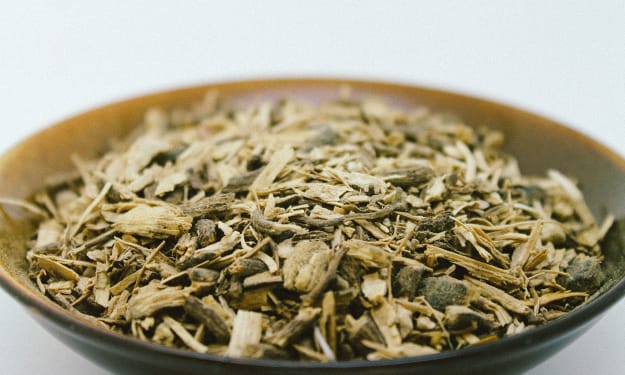
How do you identify bad or old weed?—a riddle as old as the hobby itself. Nobody wants to light up with adulterated cannabis, and, with these helpful hints, you won’t ever have to. It is important to consider the quality of your weed before smoking or otherwise consuming it. If your bud is in some way tainted, it is important to reconsider using that weed. Mold and other irregular or unnatural features should not be inhaled due to their adverse effects on respiratory health. Luckily, there are at least five sure-fire ways to determine the quality of your weed that require little experience with the plant itself. It only takes a few minutes to run a quick quality check, and it could improve your marijuana usage! Here are our top five tips of how to identify bad or old weed.
Is It Love at First Sight?

Moldy marijuana via Herb
Since mold, chemicals, and other undesirable substances in your weed can harm your health, it is important to do a thorough inspection before consumption. Quality weed should pass a quick visual test, at the very least. Okay, so it might not be love at first sight, per se,—though you may have yourself a real winner—but if what you’ve got is good, you’ll just know. Good weed is usually green, though sometimes purpleish, with tiny white crystals blanketing the entire outer bud. These crystals are called trichomes, and contain THC among other things.
The primary thing to look for when giving your weed a quick visual look-over is mold. Mold can form if weed is not stored in an appropriate cool, dry environment. Mold against weed is pretty obvious to the human eye: it is usually a gray, fuzzy layer on top of leaves and wound like a spider’s web between the stems. However, mold can sometimes be tricky to detect because it may develop in the deeper layers of the bud. Any visible abnormalities should be a clear red flag. The visual test is a great way to start on figuring out how to identify bad or old weed.
Sniff Your Stuff to Determine If It’s Up to Snuff

To the avid smoker, the sweet, herbal odor of marijuana is immediately recognizable—even among a conglomeration of smells. No, stoners don’t have a sixth sense for locating their favorite preoccupation; the distinguishable scent of weed stems from a substance known as terpenes. Secreted by the same glands involved in THC production, this oil adds flavor to the marijuana buds (generally pine, citrus, mint or berry). So in what way does smell tell you how to identify bad or old weed?
If your weed is compromised, you’ll notice a marked difference in its trademark smell. Because different strains of plants have different combinations of flavor-producing oils, the terpenes, different strains may produce slightly different aromas. Therefore, don’t be alarmed if you encounter a new smell, as it may simply be a plant strain you have not yet smoked. Avoid the three M’s: musty, moldy, and man-made. Abnormal, balmy smells may indicate improper storage and the presence of mold while man-made chemical stenches may mean incorrect usage of pesticides. Not only does this interfere with your smoking experience, but moldy or chemical-rich weed can threaten your lung health. But don’t worry if you feel your sniffer isn’t sensitive enough to pick up these slight distinctions, there are plenty of alternative methods explaining how to identify bad or old weed.
What Do Your Feelings Tell You?

Now, I don’t mean you need to get all emotional and feel the weed—though that may work for the hippies—but you do need to touch it, grab it, handle it, feel it. You’re looking for any traces of moisture, over-dryness, or over-compression. Good weed is good through and through so for a more thorough examination, pick the bud apart and check out the inside layers.
Before weed is ready for medicinal or recreational use, it must undergo a drying process during which the moisture of the recently pruned plant is heavily reduced. The weed may shrivel to a small extent, but anything that looks as if it has been squished down under the foot of an elephant is probably a no-go. This weed has probably been stored in too tight quarters without a lot of room to “breathe.” That means a higher risk of mold being in your marijuana. You should apply the other hints, especially the visual test and sniff test to be sure whether or not your weed is contaminated with mold.
Keeping this in mind, dryness can also be a red flag for cannabis users. Older weed tends to dry out and may become fragile and crumbly. If you try holding it or picking it apart and the bud becomes dusty, there is a good chance that you’ve found something that has been dried out too much. If your weed is damp or if it’s disintegrating between your fingers, you’ve got yourself an ugh-nug. If your weed seems dry without being too crispy or fragile, it might be safe to smoke, but there are other, additional tests to check the quality of your weed.
All Ears

This tip on how to identify bad or old weed is targeted at the more experienced smokers. It requires an intimate knowledge of what normal weed sounds like. So, turn down the music and listen carefully to the crumbling of your weed as you separate the bud. This sound speaks wonders about the quality of your marijuana. If all you hear is the sound of silence, you either need an updated hearing test or new cannabis. No sound at all points to the weed being too moist, which you can also determine through feeling the weed with your hands, as mentioned above. The dampness of the leaves causes the weed to resist lighting, and smoking becomes more difficult, if not impossible. This weed won’t light well and isn’t ready for smoking.
Weed should make a crisp snapping sound like the clacking of typing on a computer keyboard. However, weed that has become too dried out may make a similar cracking sound, so listen very carefully! Smoking overly dried weed dampens the calming effects of the THC and can create an uncomfortable scratching sensation or agitation in your throat.
Go For It

If your stuff appears to pass the other tests, or you are still unable to determine if your weed is bad or old and you’re pretty brave, pull out the bong and take a hit. Marijuana has a distinctive and pleasant aftertaste that is nearly as recognizable as its signature smell. There are varieties of flavors based on different strains and how they are raised. These are generally produced by the terpenes in the plant. The most common terpenes are Limonene, Myrcene, Alpha- and Beta-Pinene, Caryophyllene, and Linalool, each of which produce a distinct flavor. Because there are so many possible varieties of tastes, you may come across an unexpected or unfamiliar taste, but that does not necessarily mean that it is bad or old weed.
Aside from noticing its taste, if you do gamble and go through the troubles of packing yourself a bowl, take notice of how the weed lights and smokes. It should light easily, though marijuana does not normally burn too fast. Furthermore, cannabis can sometimes burn out. This is okay, simply relight it and try again. However if your weed is burning for a strangely long time or burning far too quickly, it may be overly dried.
If the weed somehow tastes sour or, there is probably something terribly wrong and you should probably pass on that second hit you were considering. Before applying this test, consider searching for mold in order to avoid inhaling dangerous substances that can harm your lungs.
So, how do you identify if weed is bad or old? Why does it matter? Quality matters. The better the quality of weed—a dried, green or purple bud with a sweet aroma and a snapping sound when you break it up—the more pronounced its effects will be. Seek out quality weed to avoid accidental inhalation of dangerous chemicals or even molds.
So, there you have it folks, look at it, sniff it, touch it, listen to it, and if you’re brave, give it a taste—there are plenty of ways how to identify bad or old weed.






Comments (8)
Provinding the best experience for recreational cannabis, THC friendly Club will thrill you with a wide variety of thc edibles, thc gummies au, thc gummies australia, imported fron USA California, Edibles are a hot topic in Australia despite not being readily available. Some of the most common questions among medical cannabis patients all swirl around this topic —buy edibles online legal australia, buy edibles online legal, and thc edibles australia.Edibles (or medibles) are cannabis products for oral consumption that include any food or drink infused with cannabinoids. Cannabinoids are chemical compounds found in the cannabis plant that can affect your mind and body, where to buy thc gummies in australia, buying edibles australia, weed gummies brisbane, edibles canberra, buyweedonlineaustralia, buy thc gummies australia, are thc edibles legal in australia, delta 8 gummies australia, marijuana gummies australia, weed gummies australia, cannabis edibles au, . The most common types of cannabinoids found in edibles are tetrahydrocannabinol (THC) and cannabidiol (CBD). edible gummies, edible weed gummies, edible gummies aus, edible gummies recipes, edible cbd gummies australia, edible cbd gummies australia, edibles australia buy, edibles brisbane, edible gummies aus, edible marijuanas australia, where to buy thc gummies in australia, medibles, weed gummies brisbane, weed gummies, edible gummy, cannibis gummies, cannibus gummies.delta 8 gummies australia, edibles canberra https://thcfriendlyclub.com https://thcfriendlyclub.com/thc-cart-australia/
If you are trying to buyweedonlineaustralia, and you find it challenging, 420dailyhighclub.com is the right place for you.Many Australians do buy weed and its recreational products online such as thc gummies au,thc gummies australia, buy edibles online legal australia, buy edibles online legal and many other produts. We provide a wide variety ofr cannabis products in different cities in Australia: weed in melbourne, buying weed in sydney, 420 melbourne craigslist, 420 for sale adelaide. There’s been a growing interest in weed and cannabis in general thanks to the changing laws here in Australia and overseas. This has led a lot of people to search online in the hopes to find weed 420 for sale perth, and also in their various neighbourhoods 420 near me, where to buy edibles, weed gummies melbourne, edibles melbourne. There are pathways to access medicinal cannabis with the help of a doctor or an Authorised Prescriber (AP) and soon, cannabidiol products such as CBD oil may be purchased from behind the counter of a pharmacist. Visit our dhop for the best prices and fastest delivery within Australia in 3 days maximum https://420dailyhighclub.com/product-category/cartridges/ https://420dailyhighclub.com
https://hochwertigeglobalemedikamente.com/product/kaufen-sie-ozempic-stift/ https://hochwertigeglobalemedikamente.com/product/calypsol-500-mg/ https://hochwertigeglobalemedikamente.com/product/kaufen-sie-oxycodon-80mg/ https://hochwertigeglobalemedikamente.com/product/zomorph-kaufen/ https://hochwertigeglobalemedikamente.com/product/kaufen-sie-etizolam/ https://hochwertigeglobalemedikamente.com/product/kaufen-sie-temazepam/ https://hochwertigeglobalemedikamente.com/product/kaufen-sie-lovegra-oral-jelly/ https://hochwertigeglobalemedikamente.com/product/kaufen-sie-lovegra/ https://hochwertigeglobalemedikamente.com/product/kaufen-sie-tadarise/ https://hochwertigeglobalemedikamente.com/product/kaufen-sie-cenforce/ https://hochwertigeglobalemedikamente.com/product/kaufen-sie-super-kamagra/ https://hochwertigeglobalemedikamente.com/product/kamagra-kaufen/ https://hochwertigeglobalemedikamente.com/product/kaufen-sie-kamagra-jelly/ https://hochwertigeglobalemedikamente.com/product/kaufen-sie-co-codamol/ https://hochwertigeglobalemedikamente.com/product/kaufen-sie-pregabalin/ https://hochwertigeglobalemedikamente.com/product/kaufen-sie-saxenda/ https://hochwertigeglobalemedikamente.com/product/kaufen-sie-nembutal/ https://hochwertigeglobalemedikamente.com/product/kaufen-sie-lsd-blotter/ https://hochwertigeglobalemedikamente.com/product/kaufen-sie-dmt-vape-pen/ https://hochwertigeglobalemedikamente.com/product/kaufen-sie-famotidin/ https://hochwertigeglobalemedikamente.com/product/kkaufen-sie-lexapro/ https://hochwertigeglobalemedikamente.com/product/kaufen-sie-tramadol/ https://hochwertigeglobalemedikamente.com/product/kaufen-sie-psilocybin/ https://hochwertigeglobalemedikamente.com/product/kaufen-sie-ritalin/ https://hochwertigeglobalemedikamente.com/product/kaufen-sie-methadon/ https://hochwertigeglobalemedikamente.com/product/kaufen-sie-dilaudid-8mg/ https://hochwertigeglobalemedikamente.com/product/kaufen-sie-codein/ https://hochwertigeglobalemedikamente.com/product/kaufen-sie-anonymes-mdma/ https://hochwertigeglobalemedikamente.com/product/kaufen-sie-mdma/ https://hochwertigeglobalemedikamente.com/product/blue-punisher-mdma/ https://hochwertigeglobalemedikamente.com/product/kaufen-sie-oxycodon-30mg/ https://hochwertigeglobalemedikamente.com/product/kaufen-sie-adipex-online/ https://hochwertigeglobalemedikamente.com/product/kaufen-sie-klonopin-2mg/ https://hochwertigeglobalemedikamente.com/product/gabapentin-300-mg-kaufen/ https://hochwertigeglobalemedikamente.com/product/kaufen-sie-ketamin/ https://hochwertigeglobalemedikamente.com/product/ketamin-500-mg/ https://hochwertigeglobalemedikamente.com/product/actavis-hustensaft/ https://hochwertigeglobalemedikamente.com/product/kaufen-sie-opana/ https://hochwertigeglobalemedikamente.com/product/hydrocodon-650-mg-10-mg/ https://hochwertigeglobalemedikamente.com/product/hydrocodon-325-mg/ https://hochwertigeglobalemedikamente.com/product/hydrocodon-10-mg-500-mg/ https://hochwertigeglobalemedikamente.com/product/kaufen-sie-suboxone/ https://hochwertigeglobalemedikamente.com/product/suboxone-streifen/ https://hochwertigeglobalemedikamente.com/product/kaufen-sie-subutex/ https://hochwertigeglobalemedikamente.com/product/kaufen-sie-fentanyl/ https://hochwertigeglobalemedikamente.com/product/kaufen-sie-percocet/ https://hochwertigeglobalemedikamente.com/product/kaufen-sie-morphinsulfat/ https://hochwertigeglobalemedikamente.com/product/diazepam-kaufen/ https://hochwertigeglobalemedikamente.com/product/kaufen-sie-ativan/ https://hochwertigeglobalemedikamente.com/product/rohypnol-kaufen/ https://hochwertigeglobalemedikamente.com/product/kaufen-sie-gelbes-xanax/ https://hochwertigeglobalemedikamente.com/product/greenstone-xanax/ https://hochwertigeglobalemedikamente.com/product/alprazolam-kaufen/ https://hochwertigeglobalemedikamente.com/product/kaufen-sie-zolpidem/ https://hochwertigeglobalemedikamente.com/product/kaufen-sie-dihydrocodein/ https://hochwertigeglobalemedikamente.com/product/kaufen-sie-desoxyn/ https://hochwertigeglobalemedikamente.com/product/kaufen-sie-dexedrin/ https://hochwertigeglobalemedikamente.com/product/kaufen-sie-concerta/ https://hochwertigeglobalemedikamente.com/product/vyvanse-70-mg/ https://hochwertigeglobalemedikamente.com/product/kaufen-sie-adderall-30mg/ https://hochwertigeglobalemedikamente.com/product/botox-100-einheiten/
Good for you on getting so many different opinions! That news just would be devestating and I am so https://kushbuyshop.com/ happy for you that it seems less serious than the first doctor made it to be. I can only imagine the journey it was to get that 4th opinion, my goodness! Thoughts are with you tomorrow! Good luck!!!!!!
Our mission at 420 Daily High is to provide our customers with an exceptional cannabis retail experience that speaks to local sensibilities. Through community engagement, we are committed to creating a safe and convenient place to interact with cannabis products. buy edibles online legal, buy edibles online legal australia, buy weed online, weed delivery app australia, buy weed online australia, craigslist adelaide weed, edibles australia online, 420 melbourne craigslist, 420 delivery perth, adelaide weed dealers, 420 delivery canberra, thc gummies online australia, edibles melbourne, edibles australia buy, thc edibles australia, buy edibles australia, looking for 420 sydney, weed edibles gummies australia, stiiizy australia, edibles melbourne australia, buy weed in brisbane, delta 8 gummies australia, melbourne 420 craigslist, strawberry cheesecake strain, 420 delivery gold coast, canberra weed shop, thc edibles canberra, edible thc lollies australia, where to buy weed sydney, where to buy weed in perth,buy weed perth, where to buy weed in sydney, where to buy edibles, buy weed in melbourne, thc edibles perth, where to buy weed canberra, where to buy weed in brisbane, where to get weed in melbourne, buying weed in melbourne, edibles brisbane, weed gummies sydney, thc lollies, edibles perth, thc gummies au, thc vape cartridges australia, are edibles legal in australia, moon rock buds, melbourne 420, thc vapes australia, 420 for sale adelaide, 420 near me, platinum bubba strain, purple moon rock, purple moon rocks, exhale wellness delta 8, exhale wellness delta 9, thc gummies au https://420dailyhighclub.com/ https://420dailyhighclub.com/product-category/cartridges/
If the weed somehow tastes sour or, there is probably something terribly wrong and you should probably pass on that second hit you were considering. https://ozempicweighfortloss.com/product/buy-ozempic-online/ Before applying this test, consider searching for mold in order to avoid inhaling dangerous substances that can harm your lungs.
Thanks for the interesting article! I really like weed because it helps me relax! I have been looking for the perfect weed for years and now I have chosenhttps://ozempicweighfortloss.com/product/wegovy-where-to-buy/ because it is a very light weed with no side effects! You can try this weed and I am sure you will like it too!
Thanks for the interesting article! I really like weed because it helps me relax! I have been looking for the perfect weed for years and now I have chosen https://westcoastsupply.cc/product/g-wiz/ because it is a very light weed with no side effects! You can try this weed and I am sure you will like it too!